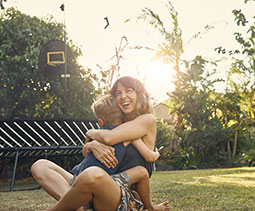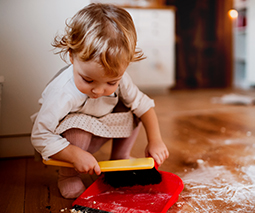I never bothered “training” my kids to use the toilet – I did this instead …

I’m pretty sure that the time when your child finally becomes toilet aware and learns how to use the toilet is up there with one of the most exciting parenting milestones. It’s a liberating feeling not having to buy nappies or wipes anymore.
Now that my youngest daughter is almost 4, I’ve enjoyed over 18 months of this bliss. But I’ve observed some very interesting (and stressful) strategies that other parents have attempted to use in order to make their child use the toilet, and it all just seems a bit much to me. The toilet-training undies, the potty, the bribes, the sticker charts … I am a real advocate of the lazy approach to toilet-learning because I believe that unless it has *clicked* in a child’s head – there’s no real point putting them through the hassle until they’re ready.
I never bothered “training” any of my four daughters to use the toilet — instead I incorporated all the tips below which I found to really help them along their journey to independent toiling.
Tip number 1: watch for signs of readiness
The first and most obvious indicator of a child beginning to be ready to learn how to use the toilet is when they are dry overnight. This demonstrates that they have increased bladder control. Another sign is when they begin to communicate to you after they have soiled their nappy, because this shows you that they are aware of the sensation and find this uncomfortable — a great time to introduce the idea of an alternative — the toilet!
Tip number 2: do your thing
And by this I mean model going to the toilet yourself, in front of your child. Let them see what it looks like for you to go to the toilet; right down to the pulling down pants, doing your business, wiping and flushing and pulling pants back up and then washing your hands. This is important for both Mum and Dad to do in front of their children! By normalising this part of your life, you’re helping demystify any confusion or shame and encouraging your child to learn about a normal, healthy hygiene habit. If they see you doing it, they’ll eventually want to do it too!
Tip number 3: make the toilet an enjoyable place to be
Try making the toilet an appealing place for your toddler to be. Find some images of whatever your child is into, and print them off and blu-tack them onto the wall. Think about adding some alphabet or counting posters, too. You could even store some books in there for toilet-reading to encourage them to go in and sit down and relax. Think sensory: make sure the toilet smells nice (a few drops of essential oil mixed with water in a little reusable spray bottle makes a good toxin-free air freshener). Maybe even let them listen to some music. Consider buying a cheap soft toddler-seat that sits on top of the toilet to make sitting a bit comfier and helping to eliminate any fear of falling through. Paired with a step-stool, this makes the toilet a place your toddler can get to and sit on all by themselves and makes the toilet less intimidating or scary.
Tip number 4: let them pee in the shower or outside
Yeah … you heard me. By allowing your child to pee in the shower or on the grass outside you’re giving them permission to see what it feels like to not pee inside a nappy. It’s a pretty different sensation for a child to experience, so if they get comfortable with it in a way where there is no pressure or expectation they will then realise that they can do it on the toilet, too. Once they make those connections about feeling like they need to go to the toilet and then going, they’re getting closer to being ready to get out of those nappies!
Tip number 5: observe fluid intake
Once your child is showing signs that they’re definitely ready to begin using the toilet you’ll be feeling a bit nervous about leaving the house with them in undies, which is understandable. One simple way to reduce the likeliness of accidents when out and empower your child, is by watching their fluid intake. Letting them have a huge drink right before you leave is probably not the best idea, and being sure to limit water intake when travelling is helpful, too. Set your child up for success.
At the end of the day, you can go about encouraging your child to use the toilet however you want, obviously. But I have found using the five tips above to be the most helpful and also the least stressful – and I also have three children with special needs. Using this “lazy” approach has honestly been so effective and also gentle on my children, and I’d encourage any parent who finds the prospect of teaching their child how to use the toilet stressful to give them a go. Good luck!









